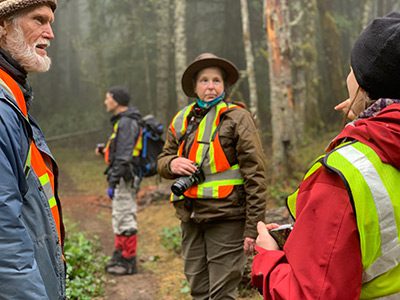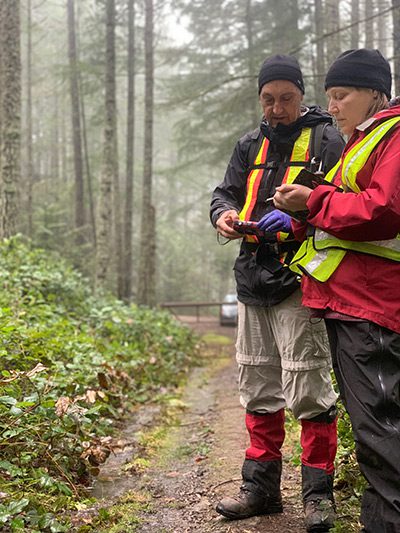
On March 2nd, some of the members of the TSS Maxwell Watershed Project Team including Ruth Waldick (TSS), Pierre Mineau (SSIC photographer), Sandra Ungerson (NSSWD Director and wetland expert), and Gary Gagné (NSSWD Director) were onsite documenting and mapping wetlands and surface water flow as a first step in understanding the hydrology of the Maxwell Creek Watershed.
In 2021 Transition Salt Spring secured $100,000 in federal funding and other support to initiate this groundbreaking research around fire risk intervention and resilience in the Maxwell Creek Watershed. This watershed project was chosen because of its importance in providing water to 5,500 residents of Salt Spring Island, and the existing fire risk to farms, homes, and wildlife habitat.
The objective of the project is to develop a better understanding of the status and current condition of the forests and local hydrology around the lake, notably, the potential for fire and the spread of fire, and to develop a strategy to reduce these risks.
We may have no control over the weather, but we do have some control over soil moisture, fuel loads and ignition risk.
Ruth Waldick (TSS)

The data the team are collecting within the watershed will help identify areas of high restoration potential:
- Notably, biologically important riparian and wetlands areas that could enhance the water holding capacity within the watershed to improve resilience to drought.
- Areas that can function as fire breaks for the spread of fire.
- Areas to increase native plant and species diversity.
Treatments and restoration that will be selected will be designed to improve the health of the overall watershed (eg., ground-surface water storage), enhance native biodiversity, reduce vulnerability to catastrophic canopy fire, and promote fire resilience. Protecting public and private lands in Coastal Douglas Fir dominated watersheds was identified as a top priority in Transition’s Climate Action Plan.

This project will span a two-year period and was developed in partnership with North Salt Spring Water District, SSI Fire and Rescue, and the two key covenant holders in this watershed, the SSI Conservancy and the SSI Water Preservation Society.
Throughout the year you’ll see the project teams’ vehicles along Maxwell road as they continue their fieldwork.
Thank you to our collaborative team members, the SSI Conservancy, the SSI Water Preservation Society, Local Trust, SSI Fire and Rescue, and North Salt Spring Water District.
